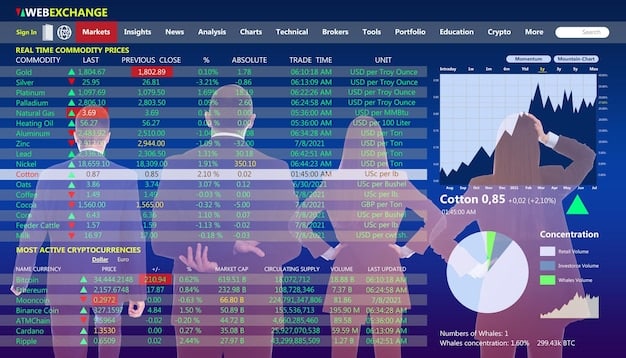Inflation’s Impact: Where Americans Will Cut Spending in 2025

In 2025, the impact of inflation on consumer spending will likely lead Americans to cut back on non-essential items such as entertainment, dining out, and travel, while also seeking more affordable alternatives for groceries and delaying major purchases.
As inflation continues to impact the economy, understanding the impact of inflation on consumer spending: where are Americans cutting back in 2025? becomes crucial, revealing evolving priorities and spending habits.
The State of Inflation in 2025
To understand where Americans will be cutting back, it’s essential to first look at the projected state of inflation in 2025. Economic forecasts play a crucial role here.
Various economic analysis point towards a fluctuating inflation landscape, with some predicting a gradual decrease while others foresee continued volatility. Understanding these forecasts is key to anticipating consumer behavior.
Economic Forecasts for 2025
Different economic models offer varying perspectives on inflation in 2025. Here’s a glimpse:
- Optimistic Projections: Expect a significant dip in inflation rates due to proactive government fiscal policy adjustments.
- Realistic Projections: Suggest a more moderate slowdown, with inflation still above historical averages but trending downward.
- Pessimistic Projections: Foresee continued high inflation, influenced by global market uncertainties and supply chain issues.
These forecasts are derived from a blend of factors, including government policies, global economic trends, and supply chain stability. Consumers often react based on media coverage and personal financial experiences.
In conclusion, the trajectory of inflation will significantly dictate where Americans choose to reduce their spending in 2025. Staying informed about the economic outlook is vital for both consumers and businesses.

Essential vs. Discretionary Spending
When inflation rises, consumers typically reassess their budgets, categorizing expenses into essential and discretionary. This distinction becomes crucial for making informed financial decisions.
Essential spending covers necessities like housing, food, and healthcare, while discretionary spending includes non-essential items and leisure activities. Understanding how these categories shift under inflationary pressures is key.
Defining Essential Expenses
Essential expenses are those necessary for basic survival and maintaining a minimum quality of life. These typically include:
- Housing costs are fundamental, whether it’s rent or mortgage payments.
- Food expenses encompass groceries and basic dietary needs.
- Healthcare costs cover insurance premiums, doctor visits, and necessary medications.
The Impact on Discretionary Spending
Discretionary spending is often the first to be cut when inflation rises. This category includes the following:
- Entertainment, such as dining out, movies, and concerts.
- Vacations and travel plans.
- Luxury goods and non-essential shopping.
Consumers often look at ways to reduce these costs through DIY, value seeking, promotions or alternative.
In summary, the divergence between essential and discretionary spending becomes more pronounced during inflation. This has impacts on particular business who may feel pressured by consumer demand.
Where Americans Will Likely Cut Back
Given the economic climate, several spending categories are likely to see significant cutbacks by American consumers in 2025. These reductions reflect both immediate needs and long-term financial strategies.
Understanding specific sectors and how consumers are adjusting their spending habits can provided insight into what may come sooner than expected. Here are a few of the areas that are more sensitive to consumer’s decisions.
Dining Out and Entertainment
Inflation often leads to reduced spending on dining out and entertainment, as these are easily scalable discretionary expenses. Instead of costly restaurant meals, more families may opt for home-cooked dishes.
The entertainment sector may also experience a decline as consumers prioritize necessities. Streaming services, movie tickets, and live events could see reduced attendance or subscriptions.
Travel and Vacations
Travel plans are frequently adjusted or postponed when inflation rises. High transportation costs and accommodation rates can make vacations seem unaffordable.
Staycations or shorter, less expensive trips may become more popular. Consumers might also look for deals and discounts to make their travel budgets stretch further.
Clothing and Apparel
Spending on clothing and apparel can decrease as consumers delay non-essential purchases. They may prioritize durable, versatile items that last longer.
Thrift shopping and buying secondhand clothing becomes more appealing. Off-season sales and discount retailers may see increased traffic.

In conclusion, consumers are willing to adjust their spending in numerous areas. Cutting back may involve sacrifices, but also encourages more creative and value concious practices.
Strategies for Saving and Budgeting
To mitigate the impact of inflation, Americans are adopting various saving and budgeting strategies. These methods range from simple expense tracking to more sophisticated financial planning.
Effective saving and budgeting strategies are essential for maintaining financial stability during inflationary periods. These tactics help families.
Budgeting Apps and Tools
The modern American family has become more dependent on budgeting apps and tools which include:
- Using mobile apps to track expenses and set spending limits, consumers can visualize and manage their budgets more effectively.
- Budgeting software provides detailed insights into cash flow and helps identify areas for potential savings.
- Spreadsheet templates offer a customizable way to monitor income and expenses, allowing for personalized financial management.
DIY Repairs and Home Improvements
Here are so ideas of DIY home repairs that will save you money over time:
- Simple plumbing repairs, such as fixing leaky faucets.
- Basic electrical fixes.
- Painting and decorating projects.
Undertaking these projects yourself can save money on contractor fees and reduce overall household expenses.
In summary, adopting effective saving and budgeting strategies can help Americans navigate inflation. Proactive financial planning is crucial for maintaining a comfortable living standard.
The Impact on Different Socioeconomic Groups
Inflation does not affect all socioeconomic groups equally; its impact varies significantly based on income level, geographic location, and other factors. Understanding these disparities is crucial for policymakers.
Lower-income households often feel the pinch more acutely due to a larger portion of their income being allocated to essential expenses. Higher-income groups may have more flexibility.
Lower-Income Households
A low-income family has a different approach to essential spending needs:
- These families may struggle to afford basic necessities during inflation.
- Increased risk of food insecurity and housing instability.
- Limited access to savings and credit, which compounds the financial strain.
Middle-Income Households
The middle-income consumer’s reactions to inflation is a crucial gauge for a pulse on the overall economy. Here are some common issues for middle-income consumers dealing with a shift in the economy:
- Middle-income families also feel the pressure but may have some savings to fall back on.
- Increased debt levels as they rely more on credit cards to cover expenses.
- Potential to delay major purchases or investments due to economic uncertainty.
In conclusion, the impact of inflation varies considerably across socioeconomic groups. Targeted policies and programs are needed to help vulnerable populations cope with rising costs.
Long-Term Financial Planning Adjustments
In light of persistent inflation, many Americans are making adjustments to their long-term financial plans. These strategies aim to protect their savings and ensure future financial security.
Long-term financial strategies are designed to create stability and mitigate risk, especially during uncertain economic times. The long-term success of this depends on economic knowledge.
Investing in Inflation-Resistant Assets
Some key assets consumers are using in an attempt to “beat” inflation:
- Real estate, can often appreciate in value during inflationary periods.
- Commodities can act as a hedge against inflation, retaining value when currency erodes.
- Inflation-indexed securities, are designed to protect investors from inflation.
Revising Retirement Plans
How retirees are dealing with inflation:
- Adjusting investment portfolios to generate higher returns.
- Delaying retirement or seeking part-time employment to supplement income.
- Cutting back on discretionary spending to preserve savings.
| Key Point | Brief Description |
|---|---|
| 📉 Spending Cuts | Americans are reducing discretionary spending like dining out and travel. |
| 💡 Budgeting Tools | Budgeting apps and DIY repairs are becoming more popular for saving money. |
| 💰 Investment Shifts | Investors are turning to inflation-resistant assets to protect their savings. |
| 🏠 Housing Adjustments | Some homeowners consider downsizing or renting to alleviate housing costs. |
Frequently Asked Questions
▼
Dining out, entertainment, travel, and luxury goods are often the first to be reduced. Since they are not required to survive, they generally are foregone during times of economic downturn.
▼
Budgeting apps track spending, helps people set limits and identify area where they can save. As the cost of living increases, many find that these apps allow for an objective lense when reviewing the budget.
▼
Lower-income households are the most affected, as a larger portion of their income goes to necessities. The smaller the budget, the larger the inflation impact is on low-income families.
▼
Real estate, commodities, and inflation-indexed securities can help protect investments during inflation. These asset classes react differently to the economy and therefore should be vetted thoroughly.
▼
Rising housing costs are forcing many to downsize, relocate, or delay homeownership. In some cases, many find that rent, utilities, and home prices are outpacing wage increases.
Conclusion
In summary, the impact of inflation on consumer spending: where are Americans cutting back in 2025? reveals an evolving financial landscape. Consumers are adjusting their budgets, adopting new saving strategies, and reassessing long-term financial plans to navigate economic uncertainty effectively.





